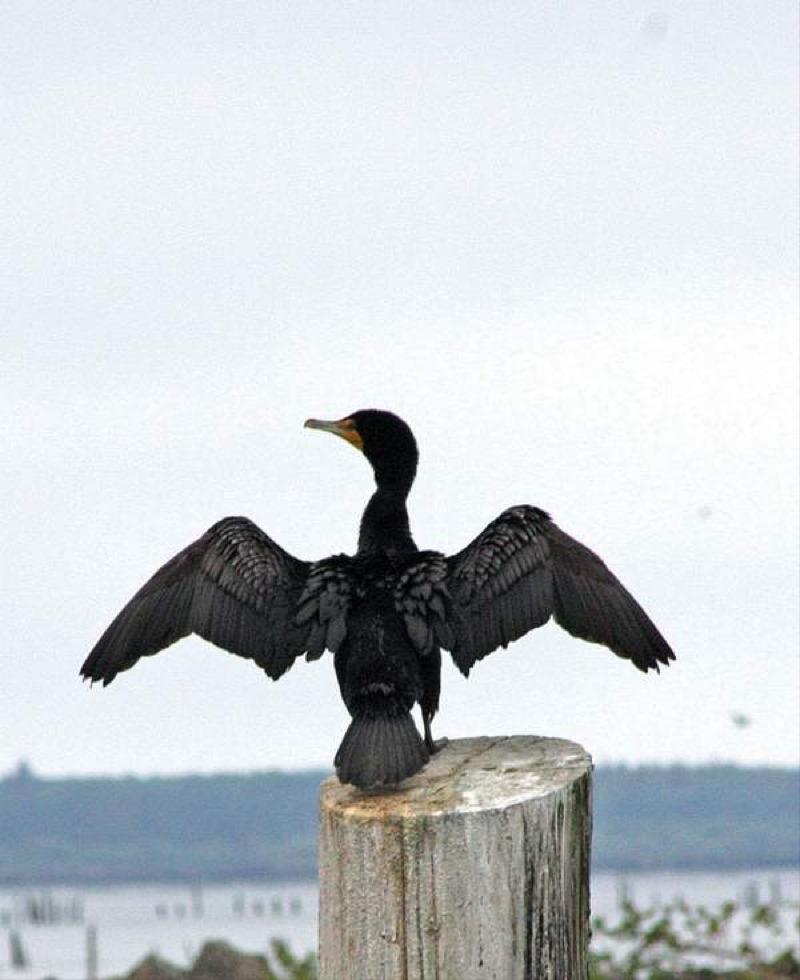
Double-crested cormorants like this one spread their wings in the sun to dry after getting them wet in the pursuit of small fish in the water. East Sand Island near Chinook is the location of a major colony of the birds.
Madeline Kalbach/Submitted Photo
Officials say thousands of cormorants abandoned their nests last weekend on an island in the Columbia River and they don't know why. Reports indicate as many as 16,000 adult birds in the colony left their eggs behind to be eaten by predators including eagles, seagulls and crows.
The birds' mysterious departure comes after the latest wave of government-sanctioned cormorant shooting. It's part of a campaign to reduce the population of birds that are eating imperiled Columbia River salmon.
Amy Echols, a spokeswoman for the U.S. Army Corps of Engineers, said the contractors who monitor the birds for the Corps reported on Monday morning that the East Sand Island colony had been significantly disturbed sometime over the weekend.
"The disturbance resulted in nest abandonment and the loss of all the cormorants eggs by avian predators like seagulls, eagles and crows," she said. "We don't know yet what the cause of the disturbance was."
Officials didn't see any evidence of a coyote or any other four-legged predator, but they did see 16 bald eagles on the island.
"Bald eagles are known to significantly startle and disperse nesting colonies," Echols said. "We don't know if that magnitude of bald eagles could have done this."
Bald eagles have been blamed for decimating Caspian tern and cormorant colonies on the island in the past. But Dan Roby, a researcher with Oregon State University who has studied the tern and cormorant colonies for decades, said he doesn't think eagles could have flushed so many cormorants off their nests.
"I'm pretty confident that's not what caused the cormorants to abandon the colony," he said. "We've seen that number of eagles out there before. We've seen them killing cormorants on their nests, and it doesn't cause that kind of abandonment."
Roby said researchers on his team did an aerial survey of the island on Tuesday and saw a large group of cormorants on another part of the island. But the nesting area was completely abandoned.
"There were absolutely no cormorants anywhere in the colony," he said. "It's a real mystery for us. It actually amazes me that any kind of disturbance – even people going on the island if that's what happened – could cause all the birds to leave their nests with eggs and then gather on the shoreline as if they were afraid to go back to their nests. It's certainly unprecedented in all the years we were out there working on that cormorant colony."
Echols said about 4,000 birds have returned to the island, but not the nesting area. A team of biologists is investigating what caused the birds to flee their nests.
Federal agents have been shooting cormorants in the area and oiling cormorant eggs on the island as part of a long-term plan to shrink the cormorant colony and reduce how many threatened and endangered salmon the birds are eating. They reported killing 209 cormorants May 12-18.
Officials haven't attributed the disturbance of the cormorant colony to any shooting or egg oiling activity. Echols said the last time the agents were oiling eggs on the island was Wednesday, May 11. Agents were on the water shooting cormorants on Monday, she said, but they have now stopped all culling activities because the number of cormorants in the colony has dropped below the level where they're required to stop.
Bob Sallinger with the Portland Audubon Society has been a vocal critic of the Corps' cormorant management plan. He said colony failure has been one of his chief concerns as federal agencies shrink the size of the cormorant population.
"When you do that, you make a population extremely vulnerable," he said. "Regardless of whether this abandonment was caused by eagles or their own activities, the fact is they've gone in there and deliberately decimated the population. Federal agencies have deliberately put the western population of cormorants at direct risk, and it needs to stop."
Echols said federal officials are monitoring the Columbia River estuary to see where all the cormorants have gone.
Roby said it's still early enough in their breeding season that the birds could still return to their nests and lay more eggs to avoid complete colony failure for the year.
